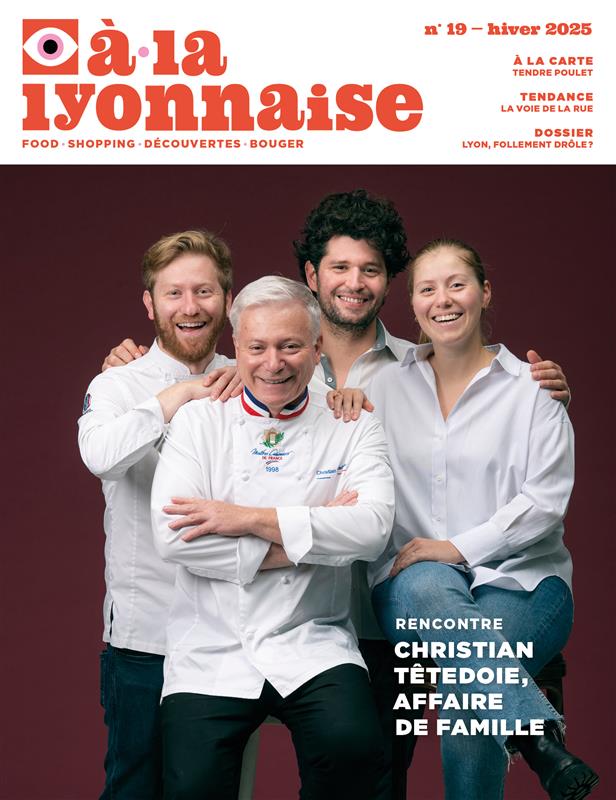Lyon, Cosplay in the spotlight

Based on american SCI-FI and greatly inspired by manga, pop culture and video games, cosplay is the art of bringing to life imaginary characters through the use of sophisticated props, costumes and make-up. It is a fun, complex form of performance art that is highly popular in Lyon. We took a deep dive into this fascinating world.
Imagine coming across Darth Vader walking arm in arm with Catwoman. Do you question your sanity? You’re probably not losing your marbles; more likely, you’ve wandered into the vicinity of a convention. By ‘convention’, we mean a gathering devoted to pop culture, where you’ll find merchandising, interactive activities and Asian food, as well as movie and online celebrities. You’ll also find cosplayers: curious individuals who look like they’ve just walked off a film set. Behind the costumes are nerds and people of all ages and backgrounds, who share an obsession with sci-fi, manga, video game or film culture, and a desire to bring their heroes into our reality.
A portmanteau of the words ‘costume’ and ‘play’, “cosplay is the art of getting dressed up, usually in a self-made costume, as a character from a fictional world, and presenting your creation as a performance in a public space,” summarised David Peyron, lecturer in Information and Communication Sciences (read more on page 33). Historically speaking, the first convention of this kind – Worldcon – was held in the late 1930s in the United States, under the stewardship of Forrest J. Ackerman, or “Mr. Science-Fiction”. It was not until 1984 that the word was used for the first time, by the Japanese film director Nobuyuki Takahashi. With a love of manga to rival that of comics in the USA at the time, Japanese fans rapidly embraced cosplay. In Europe and other countries around the world, it was not until the video-game boom and the growth of the internet, particularly in the 2000s, that this pop-culture phenomenon truly emerged.
“Cosplay truly is multi-disciplinary, it involves art but also DIY.3
Cosplayers are above all fans. It is their way of honouring their favourite works and characters. While the world of fantasy may offer a way to escape to a place with clearly defined rules and identifiable “baddies”, cosplayers are not disconnected from reality. Quite the opposite is true. “With cosplay […] it’s far simpler to socialise. I can easily have a conversation with a stranger, even without wearing a costume, while I used to have trouble asking for bread in a bakery,” explains BlakiPa. The same is true of Ayumi: “I’m a very reserved, shy person; cosplay helps me make connections with other people.”
Creativity in the digital realm
More than ever, the art of cosplay is constantly moving between reality, imagination and digital technology. It’s no surprise that social networks are the main channels used by cosplayers, since the community aspect is an intrinsic part of the movement. While the creative aspect of costume-making tends to be solitary, a lot of tips and encouragement are exchanged via platforms like Instagram and TikTok. After this stage comes the opportunity for “expression”. Cosplayers get together in the “real world”, at photo shoots or conventions, to bring to life and share their passion. Lyon just happens to be one of the centres of cosplay and it has been for more than two decades! “The city embraced the culture of conventions very early on. It’s been a magnet for video-game nerds since the 1980s with Infogrames, and then Arkane in the 1990s [Editor’s note: see issue 11 of À la lyonnaise],” ” added David Peyron. This past has made fertile ground for cosplay, with the industry’s economic might supporting geek culture. There’s no two ways about it: holding a festival costs a lot of money! Organisers need to be able to count on reliable investors, as well as willing participants to bring the event to life. All the biggest events, such as Japan Expo, the leading convention in France, are held in Paris; but Lyon has its fair share of major events, such as Festival Cosplay in April, Geek Touch and Japan Touch Haru in May, Lyon Hanabi in August, Fête du Chapelier in Sep tember, and Japan Touch in December. Our favourites include the recently held Yggdrasil. This annual festival celebrating imaginary worlds brings together fairies, trolls, Vikings, body painters, roleplayers, and lovers of mysterious cocktails concocted at Le Dragon qui Fume (the smoking dragon). So, if you’re tempted to try, there are no excuses! There’s always an opportunity during the year to express your creativity on stage during a show. You could even enter a cosplay contest where participants create full scenes (dancing, combats, performances, etc.) with props, music, accessories and videos. “Cosplay truly is multi-disciplinary; it involves art but also DIY,” told us Ayumi. “You need to be very resourceful,” added BlakiPa. The people of Lyon are obviously not lacking in this department.
Diary
Conventions are held throughout the year and are the ideal place to marvel together at the inventiveness of cosplayers from all backgrounds.
CLERMONT GEEK CONVENTION
The biggest event in the region!
16 and 17 March, Grande Halle d’Auvergne
in Clermont-Ferrand
clermontgeek.com
GEEK LEGENDS
13 and 14 April, Villeurbanne
geeklegends.fr
JAPAN TOUCH HARU
4 and 5 May, Eurexpo
japan-touch.com/haru
HERO FESTIVAL GRENOBLE
11 and 12 May, Alpexpo
herofestival.fr
Three questions for David Peyron
A nerd at heart and lecturer in Information and Communication Sciences at the University of Aix-Marseille, David Peyron studied cosplay in detail for his thesis entitled « The social construction of a subculture : The example of geek culture », which he defended in Lyon in 2012. We asked him about his findings.
What is the typical profile of a cosplayer?
This may be a surprise to some, but cosplay is an activity that requires deep knowledge and various skills. The most accomplished performances are often the work of cosplayers in their thirties. People in France tend to make their own costumes, but this still requires a significant financial investment. You need to have an income if you want to compete with the best. Of course, many teenagers start making their first costumes in their bedrooms by following online tutorials, which offer guidance to help them develop their own style.
Is there anything that sets French cosplay apart?
It’s very important for French cosplayers to have a handmade costume, unlike in Japan where performing in a purchased costume is no problem. In France, cosplay was developed by amateurs who have always wanted to bring a very personal touch to their creations. Another specificity is that French cosplayers are fans of a character first and cosplayers second. So they never have more than two or three characters in their wardrobe, and they add endless details to them over the years. In other countries, people are often cosplayers before being fans, and it’s not frowned upon to play as a character that you didn’t choose.
You consider cosplay to be the perfect example of a popular subculture; what do you mean by that?
Popular culture isn’t necessarily about having the biggest audience; it’s about being accessible and conveyable. Cosplay remains a niche activity, but if you want to be a “true” cosplayer, you need a wider knowledge of manga, comics or sci-fi, which means doing a lot of research. Authenticity is a major factor and superficiality becomes limited very rapidly. The aim is not only to copy the character but also to make the character your own, which is one of the things that makes it a cultural movement. Popular culture is also something that’s handed down through history. The heroes of Ancient Greece are today embodied in Marvel and then reinterpreted by cosplayers around the world.
Portraits
Ayumi: a personal pursuit
Ayumi usually cosplays alone. Even though she has found amazing friends through cosplay, including her maid of honour, this nutritionist likes to live her costumed adventures away from the crowds, which she finds stressful. “What I really love about cosplay, is putting the costume in a stunning setting and taking beautiful photos to keep. This way I can document the costume’s journey from start to finish.” Would she have thought when she started out, in 2014, that this hobby would earn her money? “I didn’t decide to monetize my activity, but I rapidly had two or three people who wanted to support me.” These donations help her balance the costs of her art. Turning it into a career is out of the question though, whether it’s making costumes and accessories, running stands for the video games industry, or organising conferences and shows: “I couldn’t become professional, because I don’t want to have to force myself to work on topics that don’t inspire me.”
Artemis: an outlet for free expression
In 2012, Artemis was dragged along to a convention by her group of friends. It was there that she discovered cosplayers. After “learning online and (…) making lots of mistakes,” she was in her first costume the following year. She has been hooked ever since. “It really frees me. My job as an accountant and my social life are kind of regulated and strict. Cosplay is totally different: I can create whatever I want, be whoever I want, and do whatever I want to.” With a competitive spirit, she has won several medals at the French Online Cosplay Cup, a national video contest; however, she also welcomes beginners into her workshop to share her knowledge and “help others along their path, as others did for us.”
BlakiPa: finding yourself through others
For BlakiPa, a qualified chiropodist, cosplay has been, in his words, a kind of “psychotherapy”. While going through a difficult period, looking for direction, his creations helped him overcome his complexes about his appearance. Driven by a desire to socialise and “be part of a family,” he began in 2017 with a closet costume, “with a few things hung up in it.” Later, when cosplaying as Milo James, from the animated film Atlantis: The Lost Empire, he became an online sensation... But he kept his feet on the ground: “The social networks are a dangerous game. We always want more and it can become an addiction. The important thing is to have fun doing it.”






